13 Efficient Link Building Strategies for Busy Marketers
In the past, link building was based on quantity, not quality. But today, it’s a different ball game.
If you’re a busy marketer, you have to understand that you can’t create incoming links instantly. It’s a gradual process.
The pages where you build links – specifically the quality and authority of those pages – play a key role in determining your position in the search engines.
This is where blogging comes in. When you blog consistently, you’ll get 434% more indexed pages and your inbound links grow by 97%.
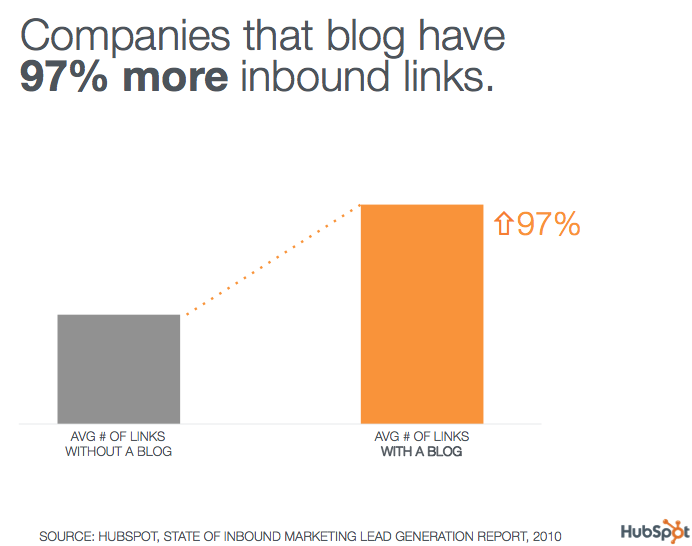
Beyond blogging, there are other proven ways to build the best links.
Download this worksheet of 13 essential link building strategies for busy marketers.
I’ll show you 13 foolproof tactics that you can put to work today. They’re especially helpful for busy marketers who want to stay productive.
1. Use Strategic Guest Blogging
More and more companies and marketers are embracing blogging, because of its benefits. According to HubSpot, businesses that blog generate an average of 97% more inbound links and 55% more site visitors. Guest blogging is likewise gaining popularity among blogging businesses.

But, how many of these companies are guest blogging the right way? If you’re strategic about it, you’ll generate lots of authority links in the process.
Being strategic simply means that you set a clear goal from the very beginning. So, if you want more traffic to your blog, then you should target blogs that will send you traffic. Here’s a case study from John F. Doherty:

That’s the power of strategic guest blogging.

Since you want more links, look for blogs where the owner and readers will be likely to share your article on social media networks and will also encourage others to do same.
You want your guest post to be syndicated on trusted platforms. When this is done, your web page will be exposed to people who will most likely link to it.
Will Blunt was strategic when he was a guest writer for HubSpot. His email list increased tremendously as a result.
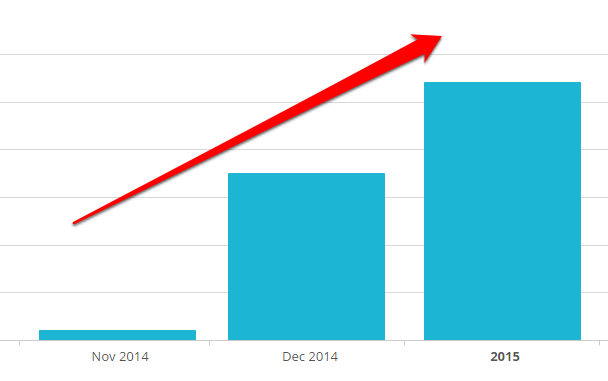
For example, if you want your guest post to rank in Google’s top 10 results, consider getting your content published on blogs that are already ranking highly. How do you find out what those blogs are?
Just go to Google and plug in the headline idea that you want to write about. Consider pitching your idea to the top resulting Google-friendly blogs for that keyword:
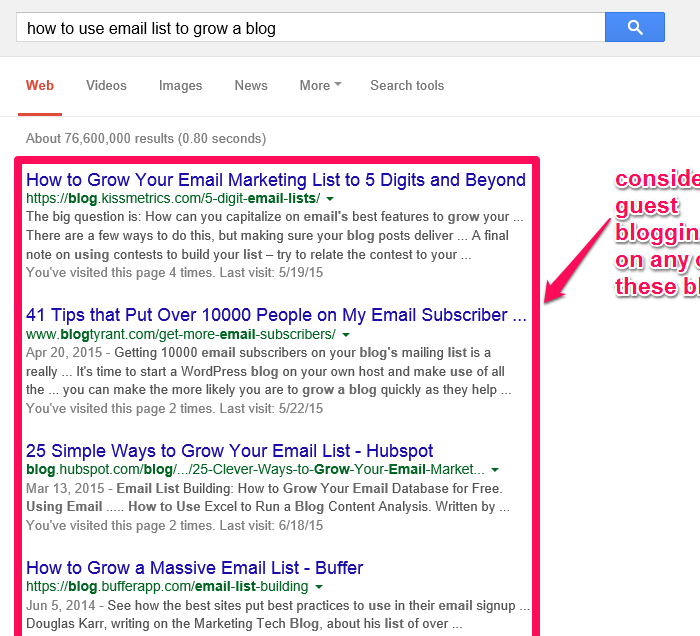
Guest blogging may be a great way to get links, but if you do it the wrong way, it can lead to Google penalizing your blog synology paketeen. That’s why you should first:
- Study the blog’s audience (get to know what they want)
- Study the popular posts (get to know the type of content that gets shared the most)
- Study the blog’s user experience
Remember that when you understand the audience that you’re writing for, it’s a lot easier to create the content that will earn you links from that audience. I know of several marketing experts who built their businesses using the power of guest blogging.

For example, Danny Iny started from scratch, but by contributing to authority blogs in a strategic way, he built FirePole Marketing, one of the most popular digital marketing companies around:
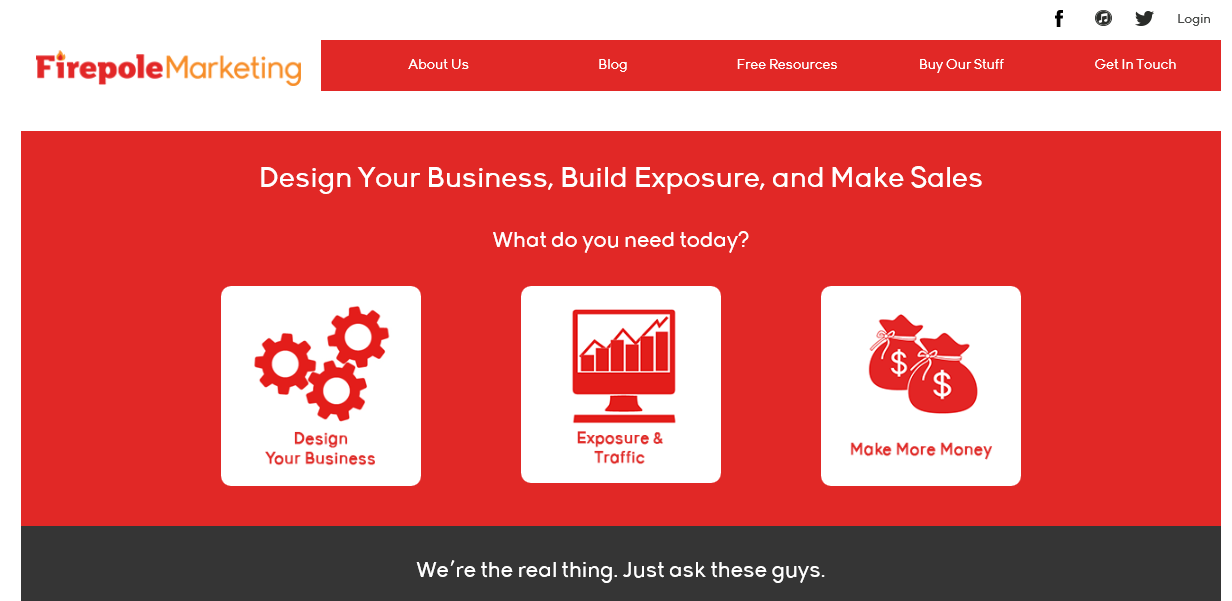
Gregory Ciotti generated 70,000 email subscribers, just by contributing regularly to trustworthy sites such as Buffer, Copyblogger and Unbounce.
He strategically focused on getting new subscribers, because having an email list of qualified buyers is the best way to build a thriving business. The below data, compiled by Litmus, an email marketing analytics company, will give you a much better understanding of the power of email marketing:
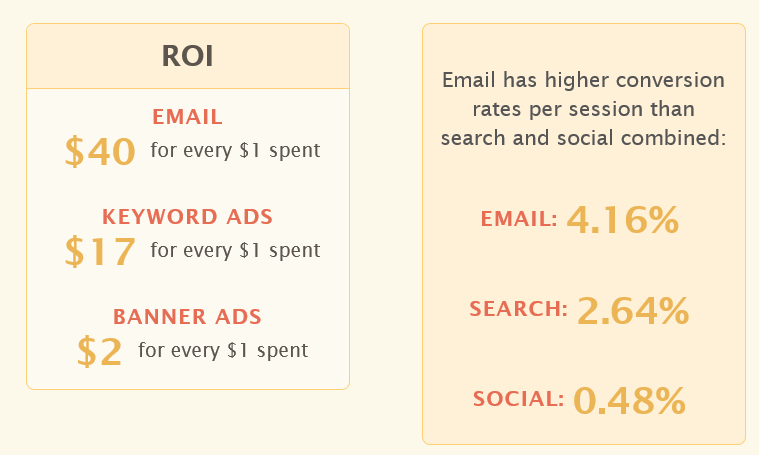
So, what’s your goal? Before you start looking for a blog to pitch, know exactly what you really want to achieve and then be strategic.
2. Create and Distribute Infographics
Don’t doubt it – infographics still work today.

According to Unbounce, the demand for infographics has increased by 800%. The human brain processes visual information 60,000x faster than plain text, which may account for the rising popularity of infographic content. Here’s the current growth pattern:

The good thing about infographics is that you’ll continually generate organic traffic to your blog and earn quality links, even when you didn’t ask for them.
I found that infographics generate 37.5% more backlinks than a standard blog post. This makes creating infographics a link building tactic that you can’t afford to ignore.
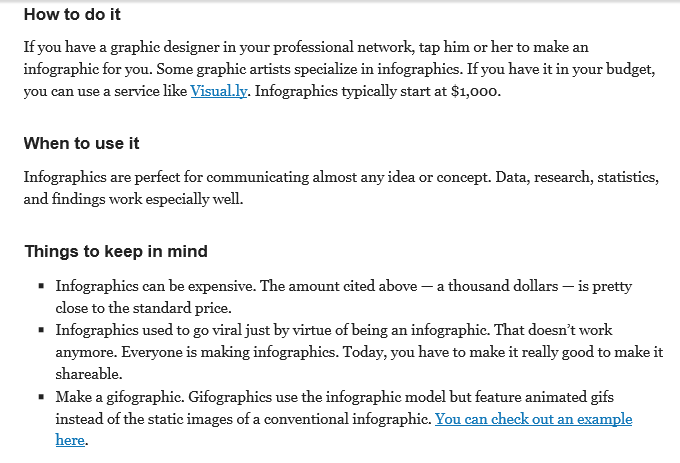
If you’re ready to create and promote your infographic, see the links below:
- How to Create and Promote Infographics to Drive 5,000 Visitors per Week
- What I Learned About Content Marketing by Analyzing 614 Posts
3. Get Active on Social Media
Social media networks have revolutionized marketing. If you’re not active on social media, then you’re doing your brand a disservice. Become active by sharing new posts, images and updates.
AdWeek discovered that companies and businesses have embraced social media marketing because that’s where engagement and relationship with new prospects and customers is fostered. Some other statistics you should know:
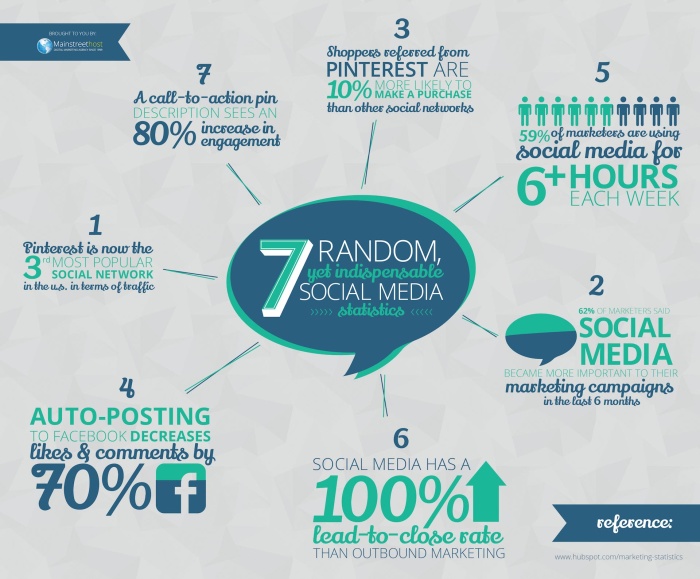
Help your fans find what they want to see, by sharing it in more places using social media.
How engaged are you on social media? According to Alterian, 7 out of 10 marketers have little understanding of social media conversations for their brands.
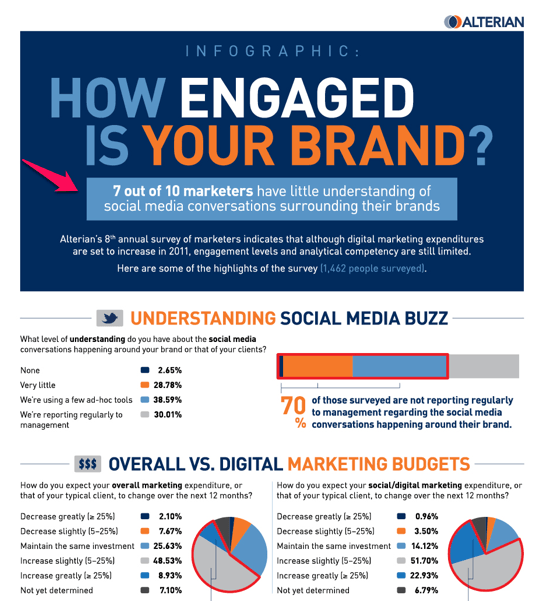
When you get active on social media, you can easily boost engagement, even if you’re new to it. Consequently, you’ll expose your brand and site URL to more people who could share your best posts with their target audience.
See also:
- How to Boost Your Social Engagement (Even if You Have No Idea What You’re Doing!)
- 16 Elements of High-Converting Facebook Pages That You Can Copy
4. Use Resource Links From Trusted Sites
It’s high time you start using resource links from trusted sites typ topen. A resource is like a guide that you create or compile for your target audience and it’s one of the 15 types of content that will drive traffic and generate quality links.
Some authority sites and blogs – sites like Forbes, Entrepreneur, Huffington Post, Jeff Bullas, Social Media Examiner and Copyblogger – have resource pages that you could tap into as you’re creating yours. If a leading site in your niche has compiled a list of blogs in your industry, their visitors can more easily find what they’re looking for.
Here’s an example:

If you can create an even bigger resource article than the one above, you’ll get more backlinks. You can expand yours to 25, 50 or more (though you should probably categorize them in some way if the total number is higher than 50).
Here are some fresh headline ideas that you can model for your resource:
- 25 Copywriting Blogs That Will Make You More Money
- 50 Copywriting Blogs You Didn’t Know Existed
- 27 Copywriting and Content Marketing Blogs That Will Send You Free Traffic
This kind of resource can be a great tool for marketing. After it’s written, get links through email outreach. Send a simple email to all of the people whose blogs you included – you can borrow or modify this template, if you like:
Hi [name of blog owner],
My name is [put your name here]. I’m the founder of [your site url here].
A few weeks ago, I discovered that your blog was listed on:
[put the exact page from the authority blog that listed them].
That was a great resource page.
I’ve written and published a more in-depth version and I linked to you. You’ll find your link on this page [put your new resource post URL here].
If you like the post and think your readers and social media fans
would benefit from it as well, I’d be grateful for a share. You could cite, share or tweet it at your own convenience.
Thank you.
[put your name here]
[put the url of your resource post again]
I’ve used a similar email template and it never fails to work. I once sent emails to 30 bloggers whom I referenced in my resource post. Twelve of them linked to my resource page within 10 days and I got lots of social love.
The highpoint: The reason why this kind of email outreach will work better than the typical broken link or link request email is because you’ve followed the blog from the authority site that first linked to them.
You’ve established a certain level of trust with them and you’ve shown some appreciation to them as well. They’ll be more inclined to reciprocate your generosity by linking to your web page.
5. Leverage the Broken Links Strategy
The broken link strategy may be the best way to go, if you’re too busy to write content or guest blog.

As a busy marketer, I know that you’ve got limited time to write content. That’s one reason why 36% of B2C content marketers struggle to create engaging content for their customers.

According to TechValidate, B2B marketers are equally stuck when it comes to creating high-impact marketing content, because of these constraints:

How does broken link building work? It’s very simple: Find pages on blogs with dead links (links that no longer work) and request that the blogger replace the broken link with a link to similar content on your own site könig der löwen 2019 herunterladen.
If I linked to a particular web page from my Neil Patel blog and I found the links to be dead, I could easily replace it with another relevant and high-value resource. If that high-value page belongs to you, that’s both SEO juice and a valuable link.
Several in-depth guides have been written to help you understand the concept of broken link building and how to get it right the first time. You’ll find these resources really helpful:
- The Black Belt Broken Link Building
- How To Use the Broken Link Strategy to Get Links
- Broken Link Building Guide: From Noob to Novice
6. Grow Your Personal Brand
The sixth failproof way to ensure that your links are useful and valuable is by growing your personal brand.
Your brand is you. In the book Designing Brand Identity, author Alina Wheeler says you should “launch internally first, then externally to key stakeholders.”
This is true of personal branding, too. Begin with you. In a nutshell, your brand evolves from your thoughts, then begins to express itself externally.

When it comes to link building that works, recognize that as your personal brand grows, people will naturally link to you.
Personally, I’ve watched as people have been linking to me without my having to ask. Whenever I publish a new post, within 24 hours I usually see new links coming from authority blogs.
In a sense, your brand represents you, like my brand represents me. So, my definition of brand is “your representative when you’re not there.” Jeff Bezos, founder of Amazon, puts it similarly:

I’ve been marketing online for over a decade. And, throughout this time, one of the most effective strategies I used to grow my personal brand was consistent blogging. When you blog consistently, you get more attention.
Of course, public speaking is also powerful, because of the potential for personal connection that comes from seeing people physically, but blogging is my #1 strategy for positioning a brand.
So, get serious about blogging, because you’ll get 97% more inbound links and that will also improve your search rankings.
7. Check Competitor’s Backlinks
According to WebpageFX, 46.2% the reason that a site ranks highly in the search engines is because of links. To put it simply, the more links that you earn from relevant, high authority websites, the higher your page will rank.

Having said that, why is it so important to check your competitors’ backlinks?
Well, it’s because you want to stay on top of what’s currently working. Google is constantly changing the game, but it seems pretty insistent on one principle: namely, that links should be earned, not built.
Moreover, you may discover that your competitors are getting links from major news sources. So, instead of feeling frustrated or accepting the status quo, let others do the hard work and learn from them.

If you find that your competitors are ranking higher that you in the search engines, it’s possible that they’re on the right track what dies herunterladen mean. You can be there, too.
There’s nothing as powerful as spying on your competitors to know where their links are coming from.
The process of spying on your competitors, in order to determine what keywords they’re ranking for, where their best links are coming from and what they’re currently doing that helps them succeed, is called “competitive analysis.”

So how do you check your competitor’s backlinks?
Simply follow these steps:
Step #1: Identify your major competitors. It’s easy to guess the web pages (not sites) that you’re likely competing with in the search engines. But, in order to be sure, you can use a simple tool to find your major competitors. Just go to SEMrush.com and plug in your main keyword. Then, hit the search button:
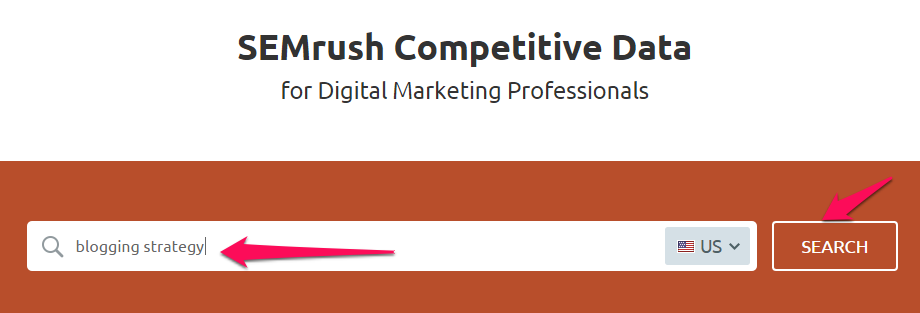
Next, scroll down the page and you’ll find the web pages that are currently ranking highly in Google organic search for that keyword.

Step #2: Analyze backlinks. Now that you know for sure which pages you’re competing with, go over to OpenSiteExplorer.com. Plug in one of the URLs you got from SEMrush and click the search button:

Next, analyze the number of links and referring web pages:
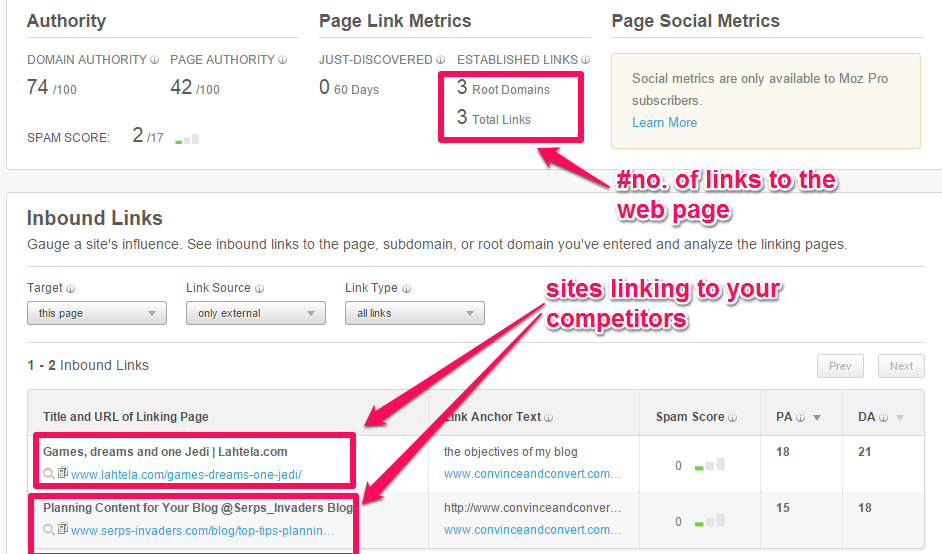
From the screenshot above, you can see that one of the competitor’s pages that sits at the top of Google has only 2 links. However, the authority of the domain name is high, which affected its rankings. Overall, this gives you an idea of what you should do.
If you want to know the domain authority and page authority of your competitor, plug the domain name (e.g. convinceandconvert.com) into the search box. Hit the search button:

Remember that when you know which sites your competitors are generating their backlinks from, you’ve won half the battle of link building, because you’ll focus on the best practices that are yielding results for others in your industry, instead of trying to reinvent the wheel.
Also, where they get their links from will tell you what strategies your competitors are currently using. This was one way Michael Chibuzor, a freelance writer, built 288 links to his niche site.

For example, if you find that several of their links are from related blogs, especially on the author profile, then it’s obvious that guest blogging is working for them.
If their links are from corporate sites, your competitors are probably getting links through outreach and networking.
On the other hand, if their links are from high-value sites such as Entrepreneur, Forbes, CNN, Huffington Post and the likes, then you should know that a columnist or editor is likely involved and this might be a paid placement.
8. Replicate Best Links From Competitors
It’s not enough to know where your competitors earned their links from. The question is, how can you replicate their success?
While you’re at it, you want to avoid getting links that would raise a red flag. For example, iAcquire said that they’re abandoning paid links. and embracing links that come directly from high-value content and social engagement.
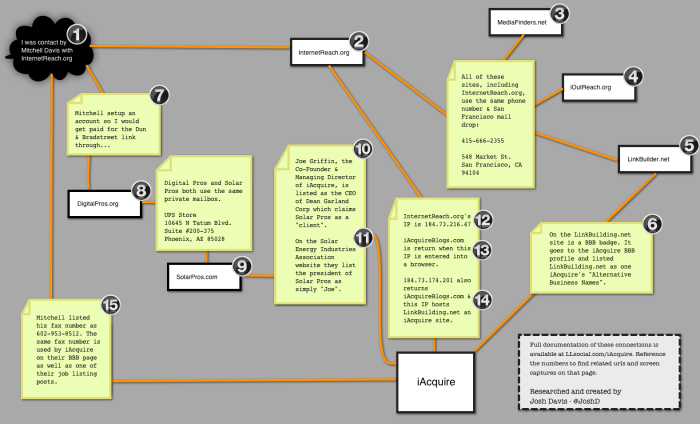
This is where social media comes in. If you want to connect with blogs and influential marketing experts, you’ve got to use social media. In 2014, Regalix found that 76% of marketers use social media to support and boost SEO.
In the SEO pyramid, if you want your links to be effective and improve your rankings, start with a strong base and build your way up herunterladen.

Replicating success is no longer a difficult task, because of the tools and resources that are available. The best links from your competitors are no longer hidden.
Once you’ve found these links, it’s time to take advantage of them. So, how do you know the best links? Well, there are lots of metrics, but the strongest are links from a site with high domain and page authority.

From the above screenshot, we see that copyblogger.com earned an editorial link from smashingmagazine.com. Let’s see how natural the link is and what kind of anchor text was used. Just click the link to visit the resource page. Here’s the link:

The anchor text used for linking to Copyblogger from Smashing Magazine’s resource page is “copywriting 101: an introduction to copywriting” – that’s natural.
The anchor text is long and descriptive. Here’s how John, founder of Blue 42 Media, sees it:
 This descriptive anchor text contains the keyword and other generic words that make it look natural. It’s a partial match anchor text, which should take up about 19% of your total anchor texts, accordings to Power of Search.
This descriptive anchor text contains the keyword and other generic words that make it look natural. It’s a partial match anchor text, which should take up about 19% of your total anchor texts, accordings to Power of Search.

So, can you replicate Copyblogger’s link success and get your own resource mentioned on smashingmagazine.com?
Follow these simple steps:
Create a relevant and high-quality resource page: To increase your chances of getting a “yes” when you email the editor, your content has to be relevant to the topic. It could be a video, an infographic, a podcast or an article.
Contact the editor: 94% of authority sites operate their blogs through one or more editors. If you think that your resource content should be on the same page on which Copyblogger’s post appears, go ahead and contact the editor. The site even provides an email address on their “contact us” page:
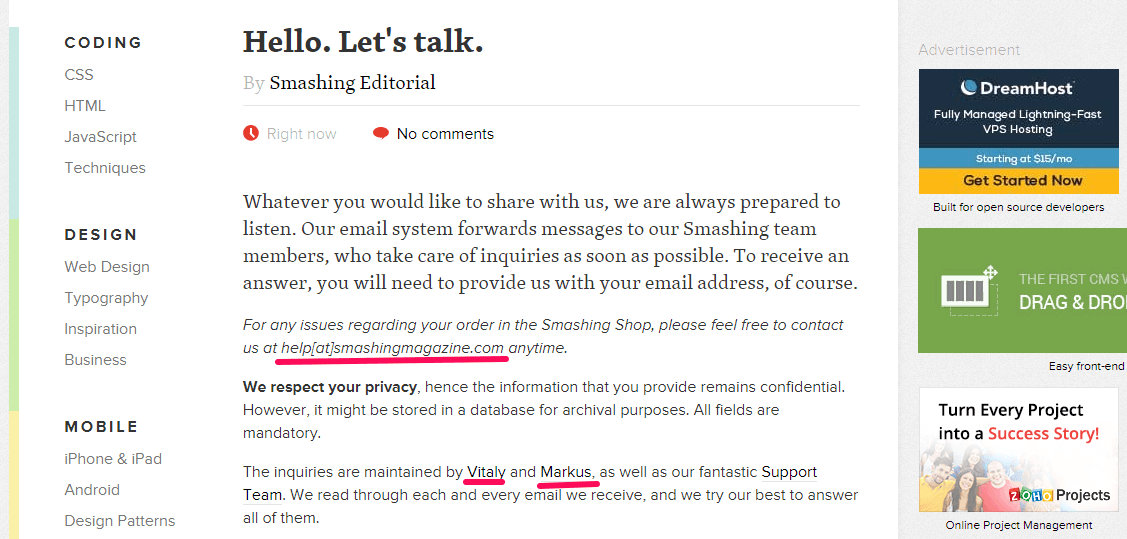
Through email outreach, you can build a relationship with the editors (Vitaly and Markus). You can even use this funny link request email template. Or, better yet, tweak it to make it unique to your voice.
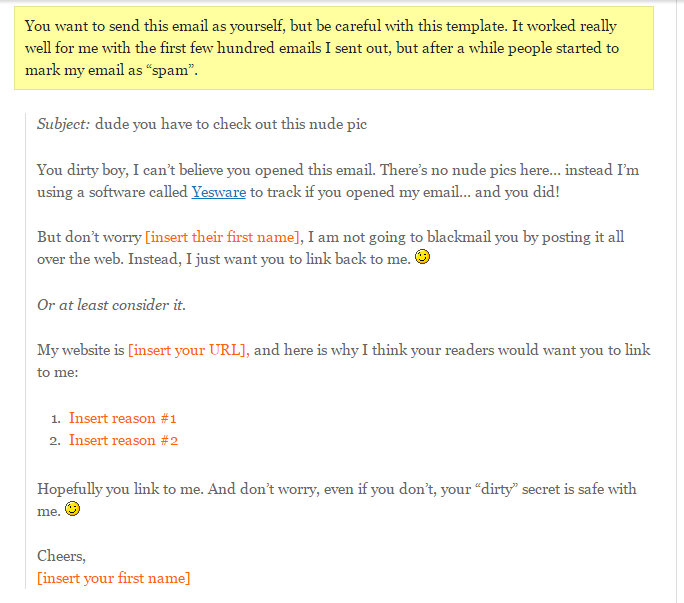
Note: Replicating your competitor’s best links may not be easy. In fact, there’s a decent chance that there was some prior relationship between your competitor and the trusted site where their links came from. But, don’t give up.
I’ve earned several links from authority sites, just by following other people’s links and providing immense value.
If your content is extremely helpful, most influential bloggers, editors and site owners will happily link back to you.
See also: The Link Builder’s Guide to Email Outreach
9. Create Link Roundups
Writing about the law of persuasion and reciprocity, Brian Tracy, the New York Times bestselling author of Goals, said that no force can stop you from getting what you want in life.

In the same vein, if you want the right links, you’ve got to give first. Don’t be selfish with your posts by linking to your internal pages only. Learn to link out to other blog posts that are useful.
If you want to stay off Google’s radar and not get penalized when you’re building links, then the only way out is through networking wie kann ich filme aus der mediathek herunterladen. To that end, a lot of bloggers do link roundups, because it’s the simplest way to share what fellow bloggers have done and show them some appreciation.
Here’s a typical link roundup post, from Digital Insights:

Link roundups are a powerful method of networking. According to Danielle Zeigler, “you get the attention of other bloggers while giving them some attention.” There are popular roundup posts, which some bloggers have made a regular feature – e.g., Running with Spoons, Sunday Link Love, Danielle Dowling’s Blogs I Heart and so on.
Link roundups (also called link love) are just lists of blog posts from bloggers – some you know and some you don’t. It’s a link building best practice because it goes beyond the links.
It works on the principle of reciprocity. In simple terms, reciprocity is the practice of getting a pleasant reward or act of kindness from someone to whom you’ve shown kindness. It’s basically “give and take.”
In a study to determine the power of reciprocity, the Massachusetts Institute of Technology discovered that reciprocity is a powerful persuasion tool. In other words, if you want people to hold you in high esteem, you’ve got to first show it by regarding them highly.

MoMA Studio recognizes that the quality of what you create will determine the quality of what you request. This means that if you create a link roundup post and reference authority blogs in a natural way, you can ask them to link back to you and are more likely to get a positive response.

So, how do you create link roundups?
First, find blog posts that are relevant to your topic. For example, if you want to compile a list of 50 blogs that deal with headline writing, you’d simply go to Google and try this search string:
intitle: roundup “YOUR KEYWORD”
While you’re at it, you may want to search different variations of the word “roundup,” because several bloggers and experts have their own favorite term:
- Linky love
- Tuesday tips
- Link love
- Friday’s best (or another day of the week)
- Mashups
- Post awards
- Weekly
- Monthly
- Roundups
- May edition
- Friday finds
- Speedlinks
- Best of
- Top 10
You also want to pay attention to your traffic and pingbacks. It’s possible that more blogs in your industry will be linking to your posts. When writing your roundup posts, start with the blogs that have sent you traffic.
Convince and Convert knows how to do a link roundup:

HubSpot also writes link roundup posts. Every other week, they compile a list of blog posts that they’ve published and they also link out to resourceful posts on other relevant blogs.
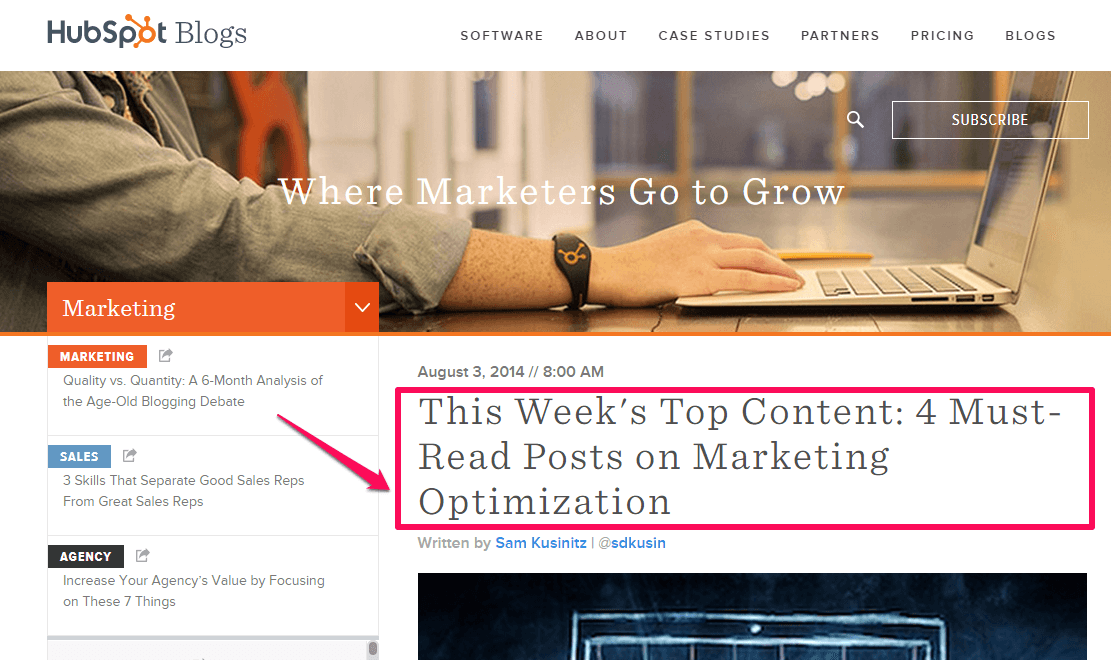
This is one of the reasons why people naturally cite HubSpot and reference their marketing statistics on their sites – not just because HubSpot conducted the study, but also because they appreciate the work of other research institutes and centers.

Remember that when you do a roundup post, don’t link solely to your internal pages. Site owners may not be inspired to link back to you, because you didn’t use the principle of reciprocity.
Link to their posts and they’ll be more likely to reciprocate by linking to your resource page.
10. Keep Track of Your Backlinks
Most people only spend time and money to get new links, but they don’t track the status. If you don’t track your backlinks, how would you know whether to build more or pause?
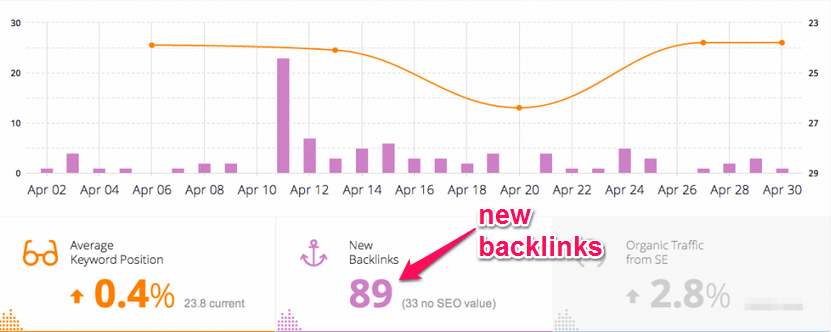
You may have over 800 links pointing to your web pages right now, but when you check it after 30 – 60 days, some of the links might be gone herunterladen.
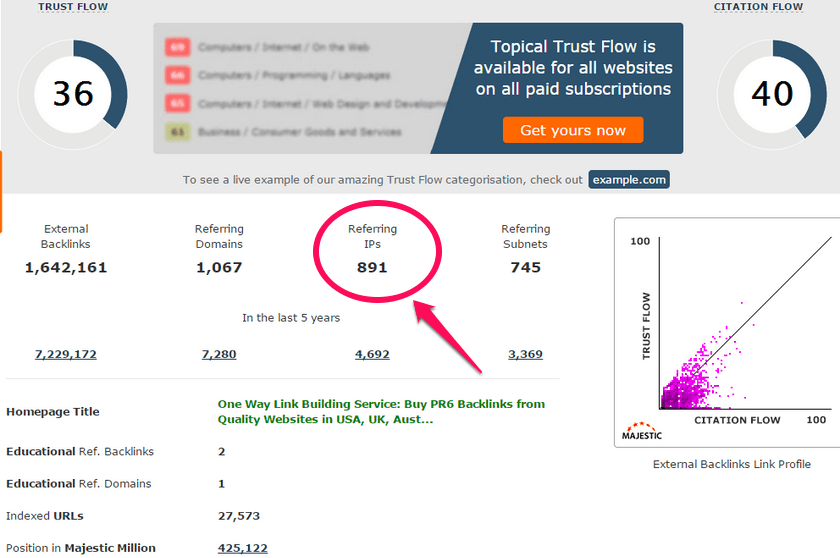
If you actively contribute to other blogs and engage your fans on social media networks, you’ll be gaining links on a regular basis.
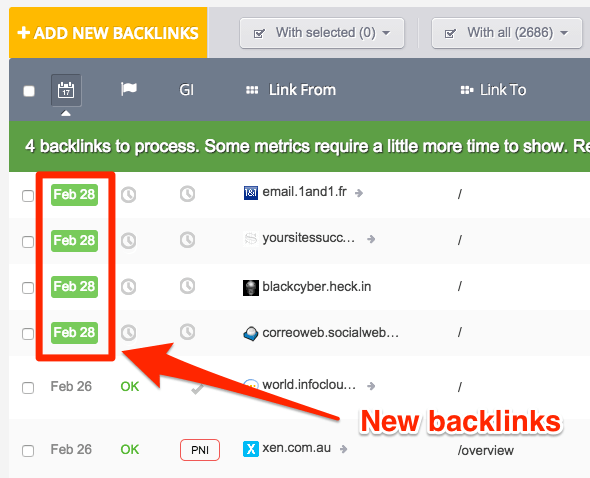
You may not realize that some of your links have been removed. Since you don’t have control over the blogs and authority sites that link to you, they can easily remove your link from their post or resource page without notifying you.
Tools, such as Monitorbacklinks.com, are a great way to know this, but that information comes at a price.

If you’re not sure of the number of backlinks that your site currently has, here’s how to find out. Visit majestic.com. On the homepage, plug in your site URL and click the orange “search” icon on the right side:

Next, analyze your links:

As you can see from the screenshot above, I’ve got 1,536 backlinks from unique IP addresses. This is good news, but how do I know if some of the links were deleted by the site owner or administrator?
Let me show you how. On the same page where you saw the number of backlinks pointing to your domain name, scroll down and you’ll find when your links were first indexed, and the last time Googlebots or spiders saw them.
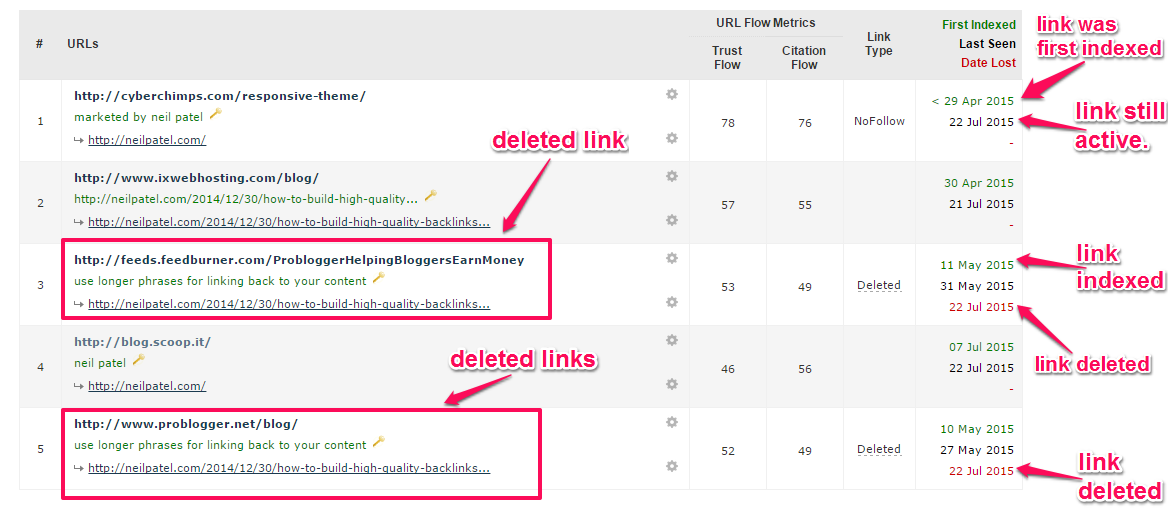
By monitoring the status of my backlinks, I can tell which blogs I need to avoid, because even if I succeed at getting links from there, the administrator (or blog author) may decide to delete my link.
11. Establish Content Pillars
If you want people to take your content seriously, then you’ve got to follow the advice Corbett Carr gave in his “Write Epic Shit” post:
Write things that make people think. Inspire people. Change lives. Create value. Blow people away with your usefulness.
Content is the lifeblood of your online business. Whether you’re selling information products, like ebooks or software, or you’re into physical products, like digital cameras and hard copy books, you’ve got to give people a reason to publicize you.
A recent research study by Cognique found that 88% of content marketers want to improve customer retention and 64% want to generate more leads. The only answer to both of these needs is to create high-quality content and promote it to the right audience – hence the term “content marketing.”

But, the challenge of creating content is the frequency. How often should you publish new content for your target audience? To be honest with you, constantly bombarding them with new posts may not be helpful, as it generally just leads to information overload.
A research study by HubSpot and Smart Insights for European customers found that 58% of the target audience across diverse markets cited concerns with content frequency.

As a content marketer, the real challenge is when and how often you need to publish new content for your prospects and customers. Of course, some of your customers wouldn’t mind if you posted daily, but, to others, that much content seems too much like a boatload of work.
This leaves you with two options:
- Ask your customers questions
- Create pillar content once in a while
If you follow the first option, you’ll likely get different responses from your email subscribers, blog readers, prospects and customers klassisches solitaire kostenlos. In turn, this would complicate the solution that you plan to provide.
The second option is a lot better. Instead of creating and publishing new content regularly, you can save yourself the hassle and only create pillar content.
What is pillar content? Here’s how Yaro Starak, founder of Entrepreneurs-Journey.com, defines it:

When you start creating pillar content, you’ll no longer struggle to write and publish new posts every day of the week, yet your traffic will grow. Derek Halpern even advises his readers to “publish less and promote more.”
Here are the things a piece of pillar content will do for you:

If you want to increase conversion rate, generate organic and referral traffic and improve your search rankings, spend more time creating pillar content. This type of content will build a strong blog for your business. And, if you’re a consultant or freelancer, you’ll attract high-paying clients.

Your pillar content pillar doesn’t need to follow any specific formula. It can be written as a guide, like this one from Moz:

You could format your content pillar using the “how to” style, as in this example from Yaro Starak:

Or, you could make your post a top list, like this one from Wordtracker.com:

12. Reclaim Links Through Social Mentions
Link reclamation is a popular topic in the SEO and social media world. You can reclaim broken 404 links and name drops that don’t link to your blog.
You can check your Google Webmaster Tools for 404 pages that people are linking to, then point them to another active and relevant page, while you fix the 404 page. Or, alternatively you could just go ahead and fix your broken page to reclaim your links.

But, we’re particularly concerned about link reclamation through social mentions. For example, in 2014, the term “westjet” was mentioned over 25,000 times across several sites and news-related portals. The question is, how many of those mentions actually linked to westjet?
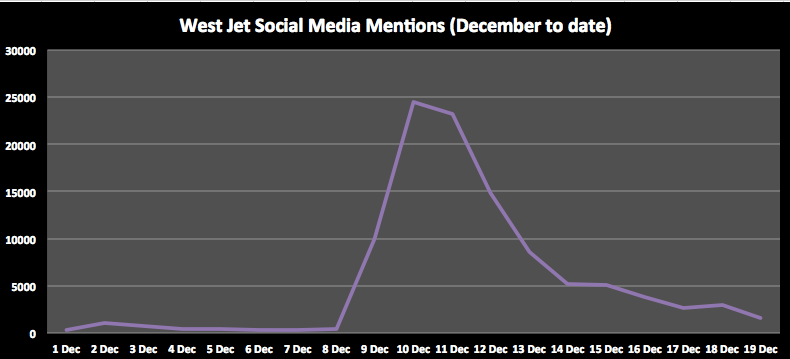
If you’ve been monitoring your brand and social media mentions using Google Alerts and not taking advantage of those mentions, then you’ve been making a mistake.
When you publish infographics with an attribution code below the graphic, your goal is to get people to embed the code on their blogs and link back to you. But, how many of these people actually use your code or link back to the primary source?
I design and promote lots of helpful infographics. A lot of sites may decide to publish my infographics for their readers to enjoy.
They’re supposed to credit my blog, Quicksprout.com (especially the web page where the infographics lives). But, what if they saved the graphic and just uploaded it to their post? How do I reclaim what rightfully belongs to me – that is, the link?
Follow these simple steps:
Step #1: Use Google Images Search. Do a keyword search for the complete title of your infographic.

Step #2: Click your infographic and visit the page. Check whether your link is attributed correctly or not.
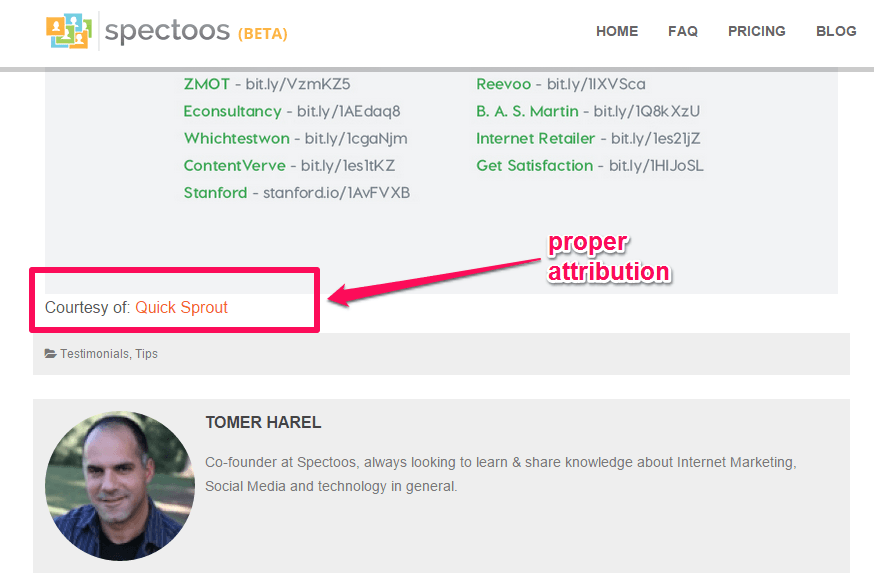
You can see that Tomer Harel linked to my infographic page on Quicksprout. Here’s another link attribution from Cox Media:
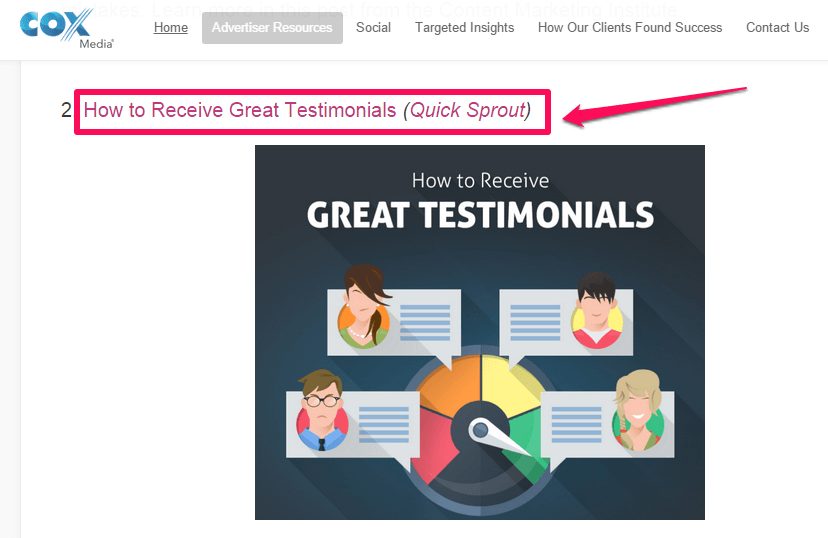
Beyond infographics, you may want to know where your blog URL is being mentioned mediathek ard film herunterladen. And, once you discover that your name or URL was mentioned, but not linked to your web page, you can ask for the link.
To find out, follow these simple steps:
Step #1: Go to socialmention.com. On the homepage, plug in your blog URL. Make sure that you select “Blog” from the drop-down list, because you want to know the blogs that mentioned you. Then, click the search button:

Next, select “last month” from the drop-down list – recent social mentions are easier to reclaim than older ones and the person who mentioned you will still have the thought fresh in their memory when you contact them.

Once you click through to the blog where your URL or name was mentioned, check whether your name or domain name was used as anchor text. If neither, then you can contact the blog owner or editor and ask them to include a link.
But, you’ve got to tread carefully and respect people. If they mentioned you out of their own generosity, asking them to link back to you could appear spammy or demanding.
Start by connecting and building a relationship with the site owner (especially if the site is authoritative and a single link from there would mean a lot). Relationship will lead to friendship. Then, you can ask politely for the link.
In a recent WhiteBoard Friday, Ross Hudgens shared some powerful tips on how to reclaim links. It’s a must-watch, if you want to take your link building to the next level:

13. Earn Editorial Links
Editorial links don’t happen by chance. They’re created when you provide value. This is what Google has been after, ever since the first Google Panda, Penguin, Hummingbird, and Mobile-geddon updates.
In a recent survey conducted by Search Engine Watch, 51.4% of respondents strongly agreed that editorial links help their search rankings. See chart below:
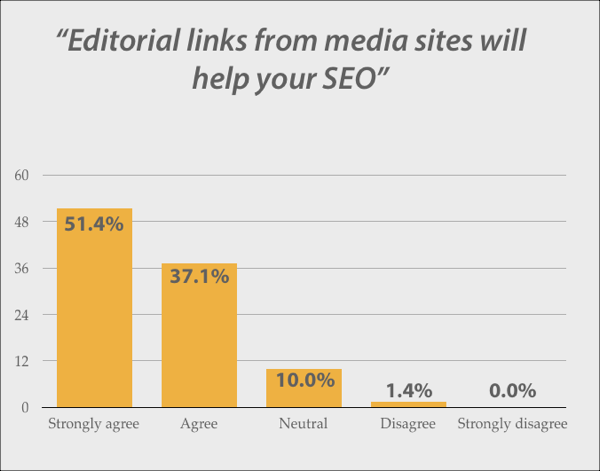
According to Search Engine College, editorial links are the most valuable and sought-after links, because they’re freely given by sites that aren’t looking for anything in return.
The nature of editorial links is this: your content has to be compelling before people will link to it.

The truth is that if all of your links are acquired or built manually, you’ll struggle to retain all of them and Google may penalize you, because you can’t be that careful all of the time. To avoid wasting time and effort, why not focus on producing great content?
Yes, I know that I’ve said it over 50 times in the past 30 days, but if it weren’t important, I’d have ignored it. I create high-quality content every day and thousands of people link to it.
One of my recent posts, entitled “22 Gmail Plugins That All Content Marketers Need To Know About” generated over 100 valuable comments already, and still counting…

This post has also generated over 50 editorial links. Majestic.com tells me that the Trust Flow and Citation Flow are 17 and 30 respectively. This shows the page is gaining strong momentum and Google loves it.

How do I know that Google and search users love the content where can I download os x mavericks? Well, the web page is ranked #3, outranking Lifehack.org (a highly trusted site).

To earn editorial links, you can start blogging with a strategy. Write content that will help people move from Point A to Point B. Create more tutorials and pillar content and make sure that you’re including accurate data in all of your content.
For further study on how to create better content that will earn you editorial links, see the resource guides below:
- The Ultimate Guide for Writing a Data-Driven Blog Post
- 10 Ways to Increase the Odds of Getting Editorial Links
- How to Double Your Writing Speed Without Lowering Its Quality
- How to Get Editorial Links From Authoritative Websites
- 9 Formatting Tactics That Will Double Your Reader’s Time on Page
Conclusion
Always remember that Google doesn’t care so much about how many links you’ve got pointing to your web pages, but rather about the experience that you create for your users.
Be smart and strategic about blogging, social media marketing, SEO and any other marketing technique that you’re using to make link building possible. Get to know what makes a link powerful and focus on improving your link power.
It’s debatable whether or not you need more traffic to your blog, but here’s what I think: you don’t have a traffic problem, but rather you’ve got a conversion problem. If you can convert more of your current visitors, your bank account will appreciate it.
In the same vein, your real challenge isn’t link building, but getting quality, trusted and natural links. That’s because it’s no longer about the quantity of links – it’s the quality that matters.
Follow these 13 foolproof best practices and you’ll be on your way to building a successful blog that your users and Google will love.
Which of these best practices have you used to get quality links to your web pages?





It’s perfect time to make some plans for the future and it
is time to be happy. I’ve read this post and if I could
I desire to suggest you some interesting things or advice.
Perhaps you could write next articles referring to this article.
I want to read more things about it!